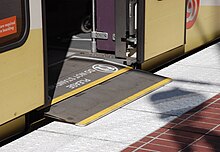Siemens SD660
- Type 2: 201–252
- Type 3: 301–327
- High floor section: 3.22 ft (980 mm)
- Low floor section: 1.18 ft (360 mm)
- 3 mph/s (1.3 m/s2) (service)
- 5 mph/s (2.2 m/s2) (emergency)
- 82.02 ft (25.00 m) (horizontal)
- 820 ft (250 m) (crest vertical)
- 1,150 ft (350 m) (sag vertical)
- Within type
- With Bombardier Type 1
The Siemens SD660, originally known as the Siemens SD600,[4] is a double-articulated, 70%-low-floor light rail vehicle (LRV) manufactured by Siemens Transportation Systems. It was the first low-floor light rail vehicle to be used in the United States.[5][6] It first entered service in 1997 with its only operator, TriMet, on the MAX light rail system in Portland, Oregon, United States.
History
The initial order placed by TriMet in May 1993 was for 39 cars. It was the first order for low-floor light rail vehicles (LRVs) in North America.[5] The order was subsequently expanded to 46 cars and ultimately to 52.[7] TriMet received the first car, which it numbered 201, in July 1996,[8][9] and the first nine cars entered service on August 31, 1997.[2][3] Siemens retroactively changed the car's model designation from SD600 to SD660, a change relating to its use of AC motors running on 60 Hz instead of DC ones, in 1998.[4] The 52nd car was received by TriMet in April 2000.[10]
TriMet later purchased 27 more SD660s (initially 17 cars, with another 10 added to the order in 2002),[11] which were built between 2003 and 2005. TriMet designated these "Type 3" in its fleet and numbered them 301–327. The last car was delivered in March 2005.[12]
All 79 SD660 cars were originally equipped with rollsign-type destination signs. TriMet replaced the original signs with LED-type signs in a two-year conversion program that lasted from fall 2014[13] to August 2016.[14]
These units are getting rewrapped into TriMet's new Phase 4 scheme that was introduced in 2018 due to the current paint schemes being bad quality. The first LRV, 250, was the first one to get rewrapped into Phase 4. Starting 2024, all of these LRVs (except for 216 that was wrecked and retired in late 2023) will get rewrapped. LRVs 215, 231, 241, and 315 have been overhauled at Siemens Mobility in Sacramento, California in order to follow the midlife overhaul program.


Features

- Bridgeplate wheelchair ramps. These are located at two of the four doorways on each side of an LRV, the two closest to the car's center.[5]
- Bi-directional (or "double-ended"), with operating cabs at both ends[5]
See also
Other Siemens light rail vehicles for the American market:
- Siemens–Duewag U2 – high-floor LRV for either level boarding at high-platform stations or steps for passenger loading at street level
- SD-100 and SD-160 – high-floor LRV for either level boarding at high-platform stations or steps for passenger loading at street level
- SD-400 and SD-460 – high-floor LRV for both level boarding at high-platform stations and with steps for passenger loading at street level
- P2000 – high-floor LRV for level boarding at high-platform stations, custom built for Los Angeles
- S700 and S70 – low-floor LRV for passenger loading at street level
- S200 – high-floor LRV for level boarding at high-platform stations
References
- ^ "SD660 Light Rail Vehicle Technical Information" (PDF). Siemens Transportation Systems. May 15, 2005. Archived from the original (PDF) on August 9, 2007.
- ^ a b "World News Review". Light Rail & Modern Tramway. No. 718. UK: Ian Allan Publishing/Light Rail Transit Association. October 1997. p. 395. ISSN 0964-9255.
- ^ a b O'Keefe, Mark (September 1, 1997). "New MAX cars smooth the way for wheelchairs". The Oregonian. p. B12.
- ^ a b "Systems News". Tramways & Urban Transit. UK: Ian Allan Publishing/Light Rail Transit Association. October 1998. p. 397. ISSN 1460-8324.
- ^ a b c d Vantuono, William C. (July 1993). "Tri-Met goes low-floor: Portland's Tri-Met has broken new ground with a procurement of low-floor light rail vehicles. The cars will be North America's first low-floor LRVs". Railway Age. pp. 49–51. ISSN 0033-8826.
- ^ "LA And Portland Get New-Design LRVs". International Railway Journal. October 1993. pp. 26–27. ISSN 0744-5326.
- ^ Oliver, Gordon (September 26, 1997). "Tri-Met expands light-rail car order". The Oregonian. p. B6.
- ^ Oliver, Gordon (August 1, 1996). "MAX takes keys to cool new model". The Oregonian. p. D1.
- ^ Wolinsky, Julian (Winter 1998). "Block Signals [regular news section]". The New Electric Railway Journal. No. 38. p. 11. ISSN 1048-3845.
- ^ "Systems News". Tramways & Urban Transit. No. 750. UK: Ian Allan Publishing/Light Rail Transit Association. June 2000. p. 227. ISSN 1460-8324.
- ^ "Systems News". Tramways & Urban Transit. No. 776. UK: Ian Allan Publishing/Light Rail Transit Association. August 2002. p. 308. ISSN 1460-8324.
- ^ "Systems News". Tramways & Urban Transit. No. 809. UK: Ian Allan Publishing/Light Rail Transit Association. May 2005. p. 196. ISSN 1460-8324.
- ^ "Worldwide Review". Tramways & Urban Transit, March 2015, p. 121. UK: LRTA Publishing.
- ^ "Worldwide Review". Tramways & Urban Transit, November 2016, p. 440. UK: LRTA Publishing.
External links
 Media related to Siemens SD660 at Wikimedia Commons
Media related to Siemens SD660 at Wikimedia Commons










